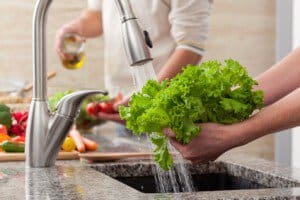
It’s important for your safety to be sure your food and kitchen are clean and food is not cross-contaminated.
The United States Food and Drug Administration (FDA) is dedicated to protecting and promoting the health of all citizens, and part of this is educating Americans on food safety issues. According to the FDA, men and women over the age of 65 are more susceptible to foodborne illnesses. This is not only because our immune systems naturally weaken over time, but because our stomach acid, which plays a part in reducing harmful bacteria in our intestinal tracts, decreases as well. The FDA recommends four major rules for maintaining food safety and preventing foodborne illnesses.
Rule #1: Clean. Unfortunately, if you are not careful, your kitchen can quickly become a haven for unwanted bacteria. First, it’s important for you to wash your hands with soap and warm water before and after handling food. Next, you should wash counter tops, dishes, utensils, and cutting boards with soap and hot water before and after preparing each food item. To sanitize your countertops and appliances, you can clean them with a mixture of one tablespoon of bleach added to one gallon of water.
Rule #2: Separate. The idea here is to prevent cross-contamination, which is bacteria from one food spreading to another. This means that you should separate raw seafood, poultry, and meats from both each other and all other foods in your grocery cart and your refrigerator. Ideally, you should have separate cutting boards for each type of food product. You should also be sure to immediately wash any utensils, dishes, or cutting boards that come into contact with raw products immediately after using them. Never place cooked food on an unwashed plate that has just touched raw food.
Rule #3: Cook. A food is considered to be safe when it is has been heated at a high enough temperature for a long enough time to kill any harmful bacteria. The times and temperatures vary per item, but you can find a helpful chart to get you started on the United States Department of Agriculture website here. To be sure items are cooked correctly, it is recommended you purchase a food thermometer, which you can use to measure the internal temperature of a cooked food item to determine if it is safe. Be sure to refer back to Rule #1 and clean the thermometer thoroughly after each use.
Rule #4: Chill. When food it left out at room temperature, bacteria will grow and double every 20 minutes. Therefore, you should refrigerate or freeze leftover prepared food items within 2 hours. The FDA also recommends that you never thaw food at room temperature, but rather in the refrigerator.


